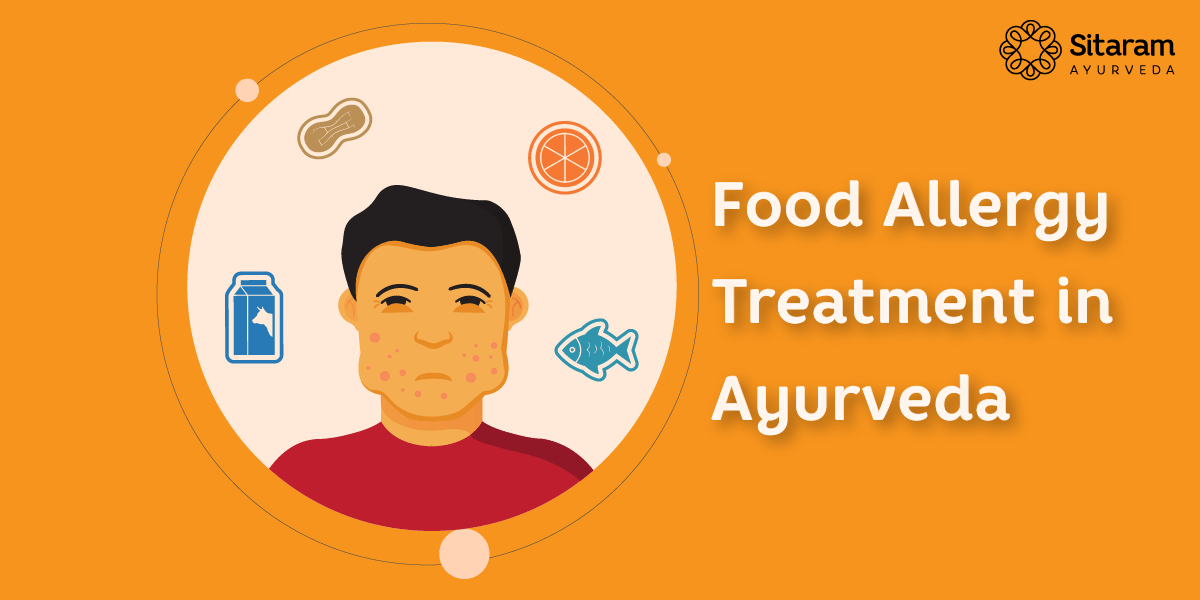Ayurvedic Management Of Food Allergy

All of us would have encountered some form of allergic reaction in our lives. It is a common condition. Allergic reactions can range from a simple itch to lethal anaphylactic reactions, which may even cause death. In most instances, the main culprit is the food itself. Here is an explanation of how Ayurveda deals with food allergies and similar conditions.
What is a Food Allergy?
Allergy is a hypersensitive reaction initiated by the immunologic mechanism of the body. Food allergy is an immune system reaction that occurs soon after eating a particular food.
Epidemiology
Studies show that food allergy is a growing concern in most developing countries. Nearly six to eight percent of children under three years of age and about three percent of adults are affected.
Types of Food Allergies
There are mainly three broad groups of immune reactions:
- Ig E( immunoglobulin E)- mediated reactions. These are immediate onset reactions arising within two hours after ingesting food.
- Non-Ig E-mediated reactions. These are delayed onset reactions that occur after four to twenty-eight hours of ingestion of food.
- Mixed
Cause
When you have a food allergy, your immune system considers the specific food as a harmful substance. Your immune system triggers cells to release immunoglobulin E to neutralize the food particle. When we eat similar food next time, these Ig E signals your immune system to release chemicals called histamines which in turn cause allergic manifestations.
Common foods that cause allergy in adults
Fish
Shellfish
Peanuts
Common foods that cause allergy in children
Cow milk
Egg
Wheat
Signs & Symptoms of Food Allergy
- Tingling or itching in the mouth
- Hives, itching, or eczema
- Swelling of the lips, face, tongue, and throat or other parts of the body
- Wheezing, nasal congestion, or trouble breathing
- Abdominal pain, diarrhea, nausea, vomiting
- Dizziness, light-headedness, fainting
- Anaphylaxis
- Food allergy may cause severe reactions in some people called anaphylaxis. Anaphylaxis may cause life-threatening symptoms and needs sudden medical attention.
Diagnosis
There are no perfect tests to confirm a food allergy. Diagnosis depends on:
- Symptoms
- Detailed history
- Physical examination
Skin prick test: A small amount of the suspected food placed on the skin of your forearm or back. Then a prick is made over the skin with a needle to allow a tiny amount of substance to go beneath your skin surface. If you are allergic, you will develop a reaction. But this is not a confirmatory test.
Blood tests
Food Allergy & Food Intolerance
Food intolerance is a less severe condition. The immune system is not involved in food intolerance.
Risk factors of Food Allergy
Experts opine that food allergy risk factors include:
Family history: There is an increased risk of food allergy if there is a history of asthma, eczema, and other allergies in your family.
Age: Allergy is common in children below three years of age.
Ayurvedic approach to Food Allergy
In Ayurveda, allergic manifestations covered a broad spectrum of diseases, which includes:
- Udarda, Seetapitha (urticaria)
- Dooshivisham (cumulative toxicity)
- Plant and animal toxins
- Food allergy described under
- Virudha Ahara( food incompatibility): This happens when you mix foods with antagonistic properties. One example is fish and milk.
- Asatmya Ahara (food intolerance)
Ayurvedic treatment for Food Allergy
The treatment for food allergy in Ayurveda depends on the signs and symptoms, and it differs person-wise. The therapy includes internal medicines, external application of medicine, and purification therapy (Panchakarma).
Internal medicines
There is a wide range of classical medicines available in Ayurveda. The form, dose, and time of administration of medication vary according to the person. Commonly practiced drugs are:
- Decoctions (Kashayam): Guloochyadi Kashayam , Patolamooladi Kashayam, Indukantham Kashayam, Amrutotharam Kashayam.
- Powders (Choornas): Triphala Choorna, Avipathi Choorna and Haridrakhandam, Allerkhand.
- Tablets (Gulika) : Vilwadi Gulika, Dooshivishari Gulika
- Ghee (Ghrutham): Tikthakam Ghrutham, Mahatikthakam Ghrutham
- Avaleha: Chyavanprasam, Dasamoolahareethaki
- Single herbs: Amla capsules and Aswagandha capsules
External application
The external application includes applying medicinal paste (Lepana) and washing with medicated water (Dhara, Kshalana). Commonly used medicines include Nimbadi powder, Triphala powder, Eladi powder, etc. We can also apply medicated oils to the skin. Dinesavallyadi Keram, Eladi Keram, Nalpamaradi Keram are some of them.
Purification Therapy
Panchakarma therapy (drug-induced vomiting, medicine-induced purgation, medicated enema, and bloodletting) is highly beneficial in food allergies. It can regulate the immune system.
Prevention
“PREVENTION IS BETTER THAN CURE”
If you find that you are allergic to a specific food, the best way is to avoid such food.
Read food labels
In the case of children, talk with persons in charge of the child and make them aware of the allergic reactions.


 Sign In
Sign In Cart
Cart
I’m very allergic, 2years to go.
I was started medicine Haridra khandam and bruhat katphaladi kashayam
Thank you for the comment. Yes, hope you have found relief by using these products. Please reach out to us if you would like to speak to our Ayurveda doctors.